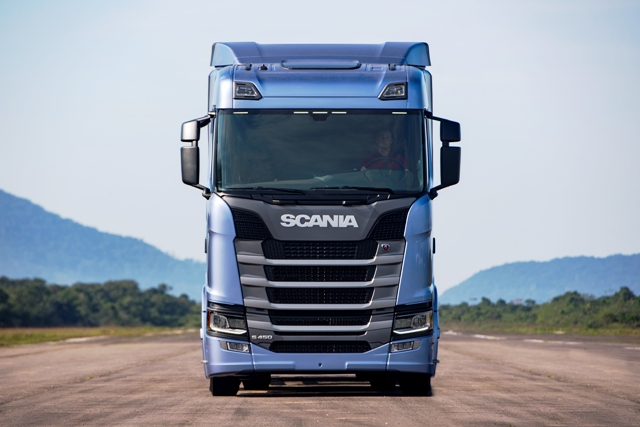SCANIA

The saga of the legendary V8 of the Scandinavian brand
Scania's V8 engine was launched in 1969 with 350 hp power. The model arrived as the most powerful diesel propeller of that year in Europe.
But the project started in 1960, when Scania's head of diesel engine design, Bengt Gadefelt, made the decision to develop an eight-cylinder engine with V architecture. This met the need for stronger propellers.
In the early 1960s, Scania had six 8- and 11-liter engines. Reaching maximum power of 250 hp.
While the market asked for stronger engines, the trend for compact, flat-cab trucks increased. Then came the challenge of fitting a V-engine into a shorter cab.
The concept developed by Gadefelt and the engineering team resulted in a 14.2-liter V8 engine. This powertrain had the attribute of high power at low speed.
Scania's V8 engine was fitted to the LB140 truck. It was quickly acclaimed by the industry. Customers also liked the appearance of the V-engine with individual cylinder heads and the 350 hp power. Combined with a torque curve at low revs.
The icing on the cake was the roar of the engine, a noise that until today is one of the biggest features of the V8.

Gadefelt, head of engineering, shows the design of the 60's V8
So far, more than 170 thousand 14-liter V8 engines have been produced, which has made it the best seller in the high production segment.
But the future of Scania's V8 engine was threatened during the late 1980s, when the manufacturer was working on the development of the Series 4 launched in 1995.
The challenge of assembling a V8 on an engine block for this project was not a simple task and divided opinions among engineering. Some were in favor of the idea of 11- and 14-liter engines that would take full advantage of the new reality of the time, which was injection technology, necessary to meet Euro 3, the pollutant emission standard in force at the time in Europe.
On the other hand, another team emphasized the importance of Scania's V8 engine as a brand image value.
To solve the problem, engineering developed a new engine configuration: a narrower, 72 ° V-architecture. As the 72 ° engine would have a very complex layout, especially the crankshaft, it was decided to develop a 90 ° engine.
Scania V8 engine gains 16 liters
The engine with a 90 ° angle and greater capacity, in addition to meeting the challenge of the emission legislation in force at the time, also adapted to the requirements of environmental laws that came with the Euro 4, 5 and 6.
With the arrival of the new millennium, the powers have evolved to 480 hp and 580 hp at 1,900 rpm and with a torque of 275.5 mkgf, more than double the original 1969 V8.
Another important step that Scania took with the new engine was modularization. Many components, including the cylinder, were the same as those used in inline engines.
The modular concept is of enormous importance for synergies in Scania's development and production, but it is also beneficial for customers, as it facilitates service, in addition to spare parts.

Another reality for the V8 engine
After the launch of the 16-liter propellant, work continued to improve its capacity.
In 2005, the company launched its widest range of engines, including 500, 560 and 620 hp V8s for Euro 3, Euro 4 and Euro 5 engines with up to 306 mkgf of torque.
With Euro 6 legislation approaching in Europe, Scania has made resources available for new engine technologies. Like exhaust gas recirculation, variable geometry turbo, common rail high pressure fuel injection, selective catalytic reduction. And more particle filtration with an exclusive engine management and exhaust technology.
The volume went from 15.6 to 16.4 liters. And a new, lighter and more resistant cylinder block in CGI (compacted graphite iron) was introduced. This allowed Scania to develop its truck with the most powerful engine in the portfolio, a V8 with 730 hp of power and 357 mkgf of torque.
When Scania introduced the Streamline trucks in 2013, the company also introduced its second generation of V8 Euro 6 engines with a power of 520 hp, 580 hp and 730 hp.
And in line with environmental demands, the griffin brand has continued to develop engines that could run on a variety of renewable fuels, so that every Scania V8 engine produced since 2015 can operate on biodiesel-HVO.

Exclusive for the driver
On board the cabin, the feeling is warm. Suitable for those who will drive for hours. As standard it is equipped with digital air conditioning, digital air deflector and air suspension control. And bed with mattress with high density foam, radio with GPS integrated in multimedia screen, individual cabin lights and refrigerator.

And because it is a Scania V8 engine truck, some finishing details are exclusive. Like the leather-trimmed seat and the V8 symbol on the vehicle's doors, dashboard and carpet.
Autonews/Mundoquatrorodas

Nenhum comentário:
Postar um comentário